Loktak Lake - lake in India
Loktak Lake (Meitei: ꯂꯣꯛꯇꯥꯛ ꯄꯥꯠ, Loktak Paat) is a freshwater lake in South Asia. It hosts Keibul Lamjao National Park, which is on the tentative list of the as of 2023. It is in the southern portion of the central bowl like plain of Manipur. It has been popular with visitors since the early 20th century for the presence of circular floating biomasses and its combination of fresh air, silvery water, adjacent mountains and good weather. The largest phumdi makes the Keibul Lamjao National Park the world's only floating national park, which is the only natural habitat for Sangai deer.
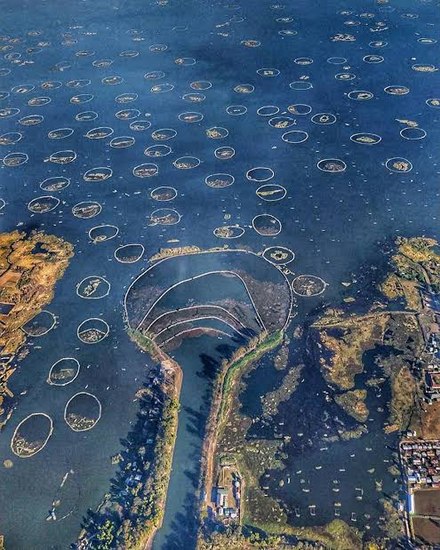
Loktak Day (Meitei: ꯂꯣꯛꯇꯥꯛ ꯅꯨꯃꯤꯠ, Loktak Numit) is celebrated every year on 15 October in and around the Loktak lake.
Understand

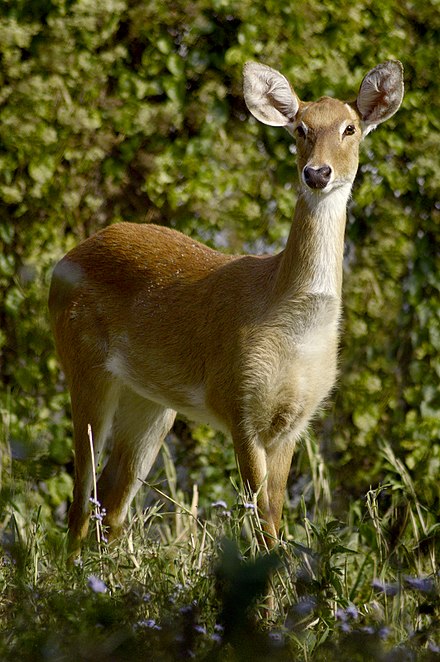 The largest of all the floating biomasses (Meitei: ꯐꯨꯝꯗꯤ, Phumdi) covers an area of 40 km² and is on the southeastern shore of the lake. It is Keibul Lamjao National Park (Meitei: ꯀꯩꯕꯨꯜ ꯂꯝꯖꯥꯎ ꯂꯩꯄꯥꯛꯀꯤ ꯂꯝꯄꯥꯛ, Keibul Lamjao Leipaak-ki Lampaak). The park is the last natural asylum place of the endangered Sangai deer, the brow-antlered deer (Meitei: ꯁꯥꯉꯥꯢ, Cervus eldi eldi). It is popularly called the "dancing deer". The park is one of the 12 geo-tourism sites in Northeast India notified by the Geological Survey of India (GSI) for promotion of geo-tourism.
The largest of all the floating biomasses (Meitei: ꯐꯨꯝꯗꯤ, Phumdi) covers an area of 40 km² and is on the southeastern shore of the lake. It is Keibul Lamjao National Park (Meitei: ꯀꯩꯕꯨꯜ ꯂꯝꯖꯥꯎ ꯂꯩꯄꯥꯛꯀꯤ ꯂꯝꯄꯥꯛ, Keibul Lamjao Leipaak-ki Lampaak). The park is the last natural asylum place of the endangered Sangai deer, the brow-antlered deer (Meitei: ꯁꯥꯉꯥꯢ, Cervus eldi eldi). It is popularly called the "dancing deer". The park is one of the 12 geo-tourism sites in Northeast India notified by the Geological Survey of India (GSI) for promotion of geo-tourism.
 The area around the Loktak Lake is pretty in characteristic, having a kind of flair and sense of history that tends to impress its visitors in a sense deeper than only from a touristic point of view. It has been known for its beauty and uniqueness for many centuries. Its atmosphere and natural surroundings have been the inspiration for an important part of the creation of the Khamba Thoibi Sheireng, a 34,000 lined Manipuri epic poetry, written by poet Hijam Anganghal.
The area around the Loktak Lake is pretty in characteristic, having a kind of flair and sense of history that tends to impress its visitors in a sense deeper than only from a touristic point of view. It has been known for its beauty and uniqueness for many centuries. Its atmosphere and natural surroundings have been the inspiration for an important part of the creation of the Khamba Thoibi Sheireng, a 34,000 lined Manipuri epic poetry, written by poet Hijam Anganghal.
The lake was designated as a Ramsar Wetland site on 23 March 1990.
Cities
- Moirang - often called the "Cradle of Manipuri culture", because of the outstanding contributions to the Meitei culture in terms of folk dance, folk music, folk tales and mythology of Meitei religion (Sanamahism).
- Ningthoukhong - best known for being a good commercial hub, full of marketplaces.
Other destinations
- Sendra – a shoreline hill near Moirang. Here, tourist resorts are available on the hilltop and boatyards are available in the foothills.
- Thanga Island - the largest island and a place known for adventure tourists and religious pilgrimages.
- Karang Island - the second largest island in the lake, human inhabited like the Thanga Island as well as a place for adventure tourists and religious pilgrimages.
Get in
By train
The nearest railway station is at Jiribam. Jiribam is connected to Silchar and Guwahati through railways. Another station is at Dimapur.
By bus
By bus, you can reach the lake by travelling to any of the shoreline cities or towns. However, Moirang is usually considered the best because it has the most widespread coverage over the peripheral regions of the lake.
Get around
What most people do to get around is boating, either through motor boats, or oaring boats, or kayaking.

By boat
Many shipyards can be found in many corners of the lake. The most popular one is just below the foothills of the Sendra hillock. Life saving swimming airbags are mandatory for every boat riders (including kayaking people) to wear for safety. These are given at free of cost. There's no charge for photography also.
By motorcycle
The best thing a motorcycle rider could do is to roam at the shoreline cities and towns of the lake.
The entire lake area is popular with motorcyclists from all over Manipur. If you want to hire a scooter, you should contact one from the tour operators in Imphal.
By bicycle
Bicycles can be rented for free at hotels, especially home stays, where you are living in. Usually, people don't charge for bicycles.
See
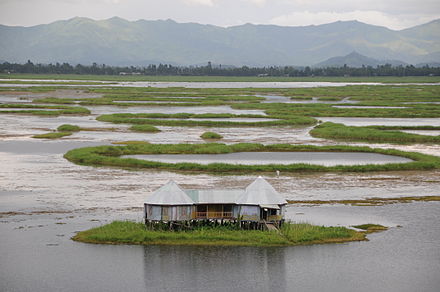
- Uncountable number of floating restaurants and floating home stays in every nook and corner of the lake. Lights shining from these floating houses make the night scene truly colourful. Besides, even lamps on posts (poles) are installed in a regular pattern across all over the lake area.
- Nurathel Garden (Manipuri: Nurathel Leikol) in the middle of the lake - it is connected to the mainland through a narrow land route. So, it's a little peninsula and not an island.
- Loktak Folklore Museum, 24.517667°, 93.81375°, +91 94364 44845. A folk museum that displays a collection of artistic, cultural and historical artefacts associated with the lake. 2022-06-15
Do
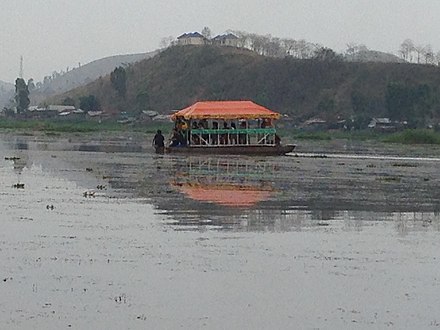
Boat trips
Take a boat trip. The most popular tourist islands are the Thanga Island and the Karang Island. Both are inhabited.
Hiking and water sports
Many make a hiking experience in the mountains and hills. There are various ways, from the easiest one to the most challenging. There are many camping sites as well as rest houses. Most roads offer spectacular views across the lake and sometimes it is even possible to see the bird's eye view of the entire lake from the top of a mountain or a hill. One popular strategic peak is the top of the Sendra Hill. The tourist office in Sendra has a larger opportunity of possibilities. The Sendra Tourist Resort is on the top of the Sendra Hill.
One can also do some water sports on the lake. However, during COVID pandemic, the water sports are occasionally allowed (generally closed), though boat riding is still allowed.
Buy
- Local handloom and handicraft products are sold at countless stalls and vendors across the shoreline regions of the lake. Garments made from Lotus stem are manufactured in the Thanga Island. Nowadays, these artworks are exported in the neighbouring towns also.
Eat
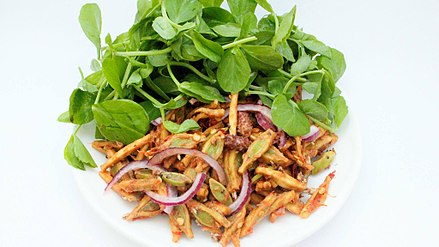 Singju – all the towns and cities around the lake avail delicious singjus. This salad is surprisingly flavorful and perfect for enjoying from a bench at the side of the lake.
Singju – all the towns and cities around the lake avail delicious singjus. This salad is surprisingly flavorful and perfect for enjoying from a bench at the side of the lake.
Fish dish (Manipuri: Ngaa Thongba) - Dishes prepared from fresh fishes caught from the lake, are no doubt, truly tasty as well as healthy.
Some of the regularly scheduled lake boats have facilities for dinner. One can order such dinners at one of the floating restaurants also.
Drink
Every hotels and restaurants in both terrestrial (shoreline or within the land mass) as well as aquatic (floating) avail drinks of various types.
Some lake boats have provisions of drinks.
Sleep
Sleep either at the floating home stays, floating around the lake or at the hotels in the shoreline regions of the lake.
Stay safe
- If you are a white person, some local villagers may want to take your photograph or even a group selfie. Don't worry! Just allow them to take your photos. Such thing is less common in urban areas, though sometimes anyone can do it. If you are an Indian or any South Asian, you may be assumed as a local by others.
- Beware of stormy wind in the surroundings of the lake, though it rarely happened.
- Do not try to swim across the lake: it's larger than it seems, wide and very deep. If you want to try, there are special events where locals and tourists can try this challenge safely by wearing swimming airbags, arranging support boats and prepared rescue teams. You can ask for this at the tourist office.

- The floating biomasses (Manipuri: Phumdi) (especially a big one) will act as your life savers, if in case, you are drowning. Never forget that when you are on a phumdi, you will never drown, though the surface of the phumdi is not stable like a concrete land surface.